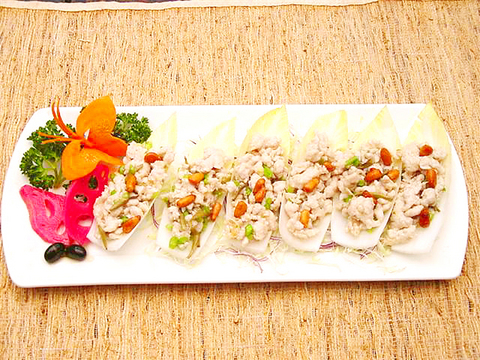Hidden in a small alley right behind the fancy Sherwood Taipei, the Is Tea Restaurant is a place full of traditional Taiwanese elegance. The lighting inside the restaurant gives the place a warm atmosphere. The wall along the walkway by the entrance is decorated with elegant teapots. Pottery decorations are designed by the proprietor's artist friend. There is also refined Chinese calligraphy and graceful Chinese paintings.
The Chinese name of the restaurant was adopted from the title of a poem written by Wang Wei (王維), a well-known poet from the Tang dynasty.
The owner Steve Huang (黃德昌) set up the restaurant in 1996.

PHOTO: DEREK LEE, TAIPEI TIMES
After much trial and error in creating new dishes using tea, the hard work paid off when his restaurant started to gain popularity in 1999. The restaurant is popular with Japanese tourists. Japan Asia Airways includes an introduction to the restaurant in a film shown during Taiwan-bound flights.
"My restaurant enjoys a bigger name in Japan than in Taiwan," Huang said.
His words can perhaps be verified by the fact that the restaurant is packed with Japanese patrons almost every weekend.
Huang uses his extensive knowledge of Chinese tea to create unique cuisine. He uses green tea to cook seafood, Oolong tea with chicken, black tea and Pu-er tea with red meat.
Methods used in the preparation of the food includes smoking ingredients with tea leaves or marinating them overnight in tea infusions.
The tea leaves that Huang uses for consumption in the restaurant are all supplied by award-winning tea farms in Taiwan.
From these top-quality tea leaves, around 40 gourmet dishes are made.
In fact, the restaurant is like a common tea house which provides a wide variety of teas to drink, served in covered white teacups.
Huang's signature dishes include bai-hao tea chicken roll (白毫玉葉雞米), diced chicken cooked with black tea (紅茶雞丁), skewers of mushroom deep fried with black tea (

May 11 to May 18 The original Taichung Railway Station was long thought to have been completely razed. Opening on May 15, 1905, the one-story wooden structure soon outgrew its purpose and was replaced in 1917 by a grandiose, Western-style station. During construction on the third-generation station in 2017, workers discovered the service pit for the original station’s locomotive depot. A year later, a small wooden building on site was determined by historians to be the first stationmaster’s office, built around 1908. With these findings, the Taichung Railway Station Cultural Park now boasts that it has

Wooden houses wedged between concrete, crumbling brick facades with roofs gaping to the sky, and tiled art deco buildings down narrow alleyways: Taichung Central District’s (中區) aging architecture reveals both the allure and reality of the old downtown. From Indigenous settlement to capital under Qing Dynasty rule through to Japanese colonization, Taichung’s Central District holds a long and layered history. The bygone beauty of its streets once earned it the nickname “Little Kyoto.” Since the late eighties, however, the shifting of economic and government centers westward signaled a gradual decline in the area’s evolving fortunes. With the regeneration of the once

The latest Formosa poll released at the end of last month shows confidence in President William Lai (賴清德) plunged 8.1 percent, while satisfaction with the Lai administration fared worse with a drop of 8.5 percent. Those lacking confidence in Lai jumped by 6 percent and dissatisfaction in his administration spiked up 6.7 percent. Confidence in Lai is still strong at 48.6 percent, compared to 43 percent lacking confidence — but this is his worst result overall since he took office. For the first time, dissatisfaction with his administration surpassed satisfaction, 47.3 to 47.1 percent. Though statistically a tie, for most

In February of this year the Taipei Times reported on the visit of Lienchiang County Commissioner Wang Chung-ming (王忠銘) of the Chinese Nationalist Party (KMT) and a delegation to a lantern festival in Fuzhou’s Mawei District in Fujian Province. “Today, Mawei and Matsu jointly marked the lantern festival,” Wang was quoted as saying, adding that both sides “being of one people,” is a cause for joy. Wang was passing around a common claim of officials of the People’s Republic of China (PRC) and the PRC’s allies and supporters in Taiwan — KMT and the Taiwan People’s Party — and elsewhere: Taiwan and